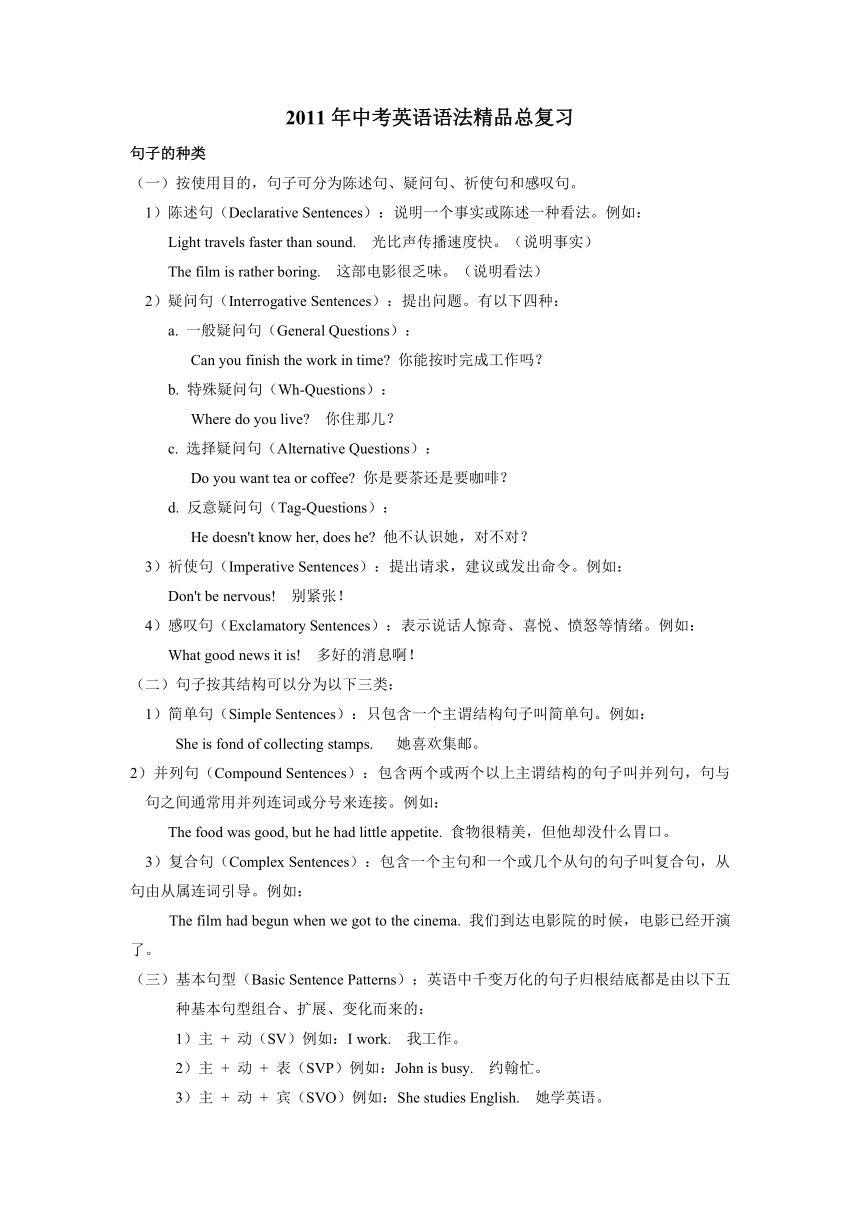2011年中考英语语法精品总复习十三 句子的种类
文档属性
| 名称 | 2011年中考英语语法精品总复习十三 句子的种类 |  | |
| 格式 | zip | ||
| 文件大小 | 11.2KB | ||
| 资源类型 | 教案 | ||
| 版本资源 | 通用版 | ||
| 科目 | 英语 | ||
| 更新时间 | 2011-06-17 08:40:17 | ||
图片预览

文档简介
2011年中考英语语法精品总复习
句子的种类
(一)按使用目的,句子可分为陈述句、疑问句、祈使句和感叹句。
1)陈述句(Declarative Sentences):说明一个事实或陈述一种看法。例如:
Light travels faster than sound. 光比声传播速度快。(说明事实)
The film is rather boring. 这部电影很乏味。(说明看法)
2)疑问句(Interrogative Sentences):提出问题。有以下四种:
a. 一般疑问句(General Questions):
Can you finish the work in time 你能按时完成工作吗?
b. 特殊疑问句(Wh-Questions):
Where do you live 你住那儿?
c. 选择疑问句(Alternative Questions):
Do you want tea or coffee 你是要茶还是要咖啡?
d. 反意疑问句(Tag-Questions):
He doesn't know her, does he 他不认识她,对不对?
3)祈使句(Imperative Sentences):提出请求,建议或发出命令。例如:
Don't be nervous! 别紧张!
4)感叹句(Exclamatory Sentences):表示说话人惊奇、喜悦、愤怒等情绪。例如:
What good news it is! 多好的消息啊!
(二)句子按其结构可以分为以下三类:
1)简单句(Simple Sentences):只包含一个主谓结构句子叫简单句。例如:
She is fond of collecting stamps. 她喜欢集邮。
2)并列句(Compound Sentences):包含两个或两个以上主谓结构的句子叫并列句,句与句之间通常用并列连词或分号来连接。例如:
The food was good, but he had little appetite. 食物很精美,但他却没什么胃口。
3)复合句(Complex Sentences):包含一个主句和一个或几个从句的句子叫复合句,从句由从属连词引导。例如:
The film had begun when we got to the cinema. 我们到达电影院的时候,电影已经开演了。
(三)基本句型(Basic Sentence Patterns):英语中千变万化的句子归根结底都是由以下五种基本句型组合、扩展、变化而来的:
1)主 + 动(SV)例如:I work. 我工作。
2)主 + 动 + 表(SVP)例如:John is busy. 约翰忙。
3)主 + 动 + 宾(SVO)例如:She studies English. 她学英语。
4)主 + 动 + 宾 + 补(SVOC)例如:Time would prove me right. 时间会证明我是对的。
5)主 + 动 + 间宾 + 直宾(SVOiOd)例如:My mother made me a new dress. 我母亲给我做了一件新衣裳。
祈使句结构
祈使句用以表达命令,要求,请求,劝告等。
1)祈使句有两种类型,一种是以动词原形开头,在动词原形之前加do (但只限于省略第二人称主语的句子)。例如:
Take this seat. 坐这儿。
Do be careful. 务必小心。
否定结构:例如:
Don't move. 不准动。
Don't be late. 不要迟到。
2)第二种祈使句以let开头。
Let 的反意疑问句:
a. Let's 包括说话者。例如:
Let's have another try, shall we / shan't we = Shall we have another try 我们再试一次,如何?
b. Let us 不包括说话者。例如:
Let us have another try,will you / won't you = Will you please let us have another try 你让我们再试一次,好吗?
否定结构:例如:
Let's not talk of that matter. 不要谈这件事。
Let us not talk of that matter. 你不要让我们谈这件事。
句子的种类
(一)按使用目的,句子可分为陈述句、疑问句、祈使句和感叹句。
1)陈述句(Declarative Sentences):说明一个事实或陈述一种看法。例如:
Light travels faster than sound. 光比声传播速度快。(说明事实)
The film is rather boring. 这部电影很乏味。(说明看法)
2)疑问句(Interrogative Sentences):提出问题。有以下四种:
a. 一般疑问句(General Questions):
Can you finish the work in time 你能按时完成工作吗?
b. 特殊疑问句(Wh-Questions):
Where do you live 你住那儿?
c. 选择疑问句(Alternative Questions):
Do you want tea or coffee 你是要茶还是要咖啡?
d. 反意疑问句(Tag-Questions):
He doesn't know her, does he 他不认识她,对不对?
3)祈使句(Imperative Sentences):提出请求,建议或发出命令。例如:
Don't be nervous! 别紧张!
4)感叹句(Exclamatory Sentences):表示说话人惊奇、喜悦、愤怒等情绪。例如:
What good news it is! 多好的消息啊!
(二)句子按其结构可以分为以下三类:
1)简单句(Simple Sentences):只包含一个主谓结构句子叫简单句。例如:
She is fond of collecting stamps. 她喜欢集邮。
2)并列句(Compound Sentences):包含两个或两个以上主谓结构的句子叫并列句,句与句之间通常用并列连词或分号来连接。例如:
The food was good, but he had little appetite. 食物很精美,但他却没什么胃口。
3)复合句(Complex Sentences):包含一个主句和一个或几个从句的句子叫复合句,从句由从属连词引导。例如:
The film had begun when we got to the cinema. 我们到达电影院的时候,电影已经开演了。
(三)基本句型(Basic Sentence Patterns):英语中千变万化的句子归根结底都是由以下五种基本句型组合、扩展、变化而来的:
1)主 + 动(SV)例如:I work. 我工作。
2)主 + 动 + 表(SVP)例如:John is busy. 约翰忙。
3)主 + 动 + 宾(SVO)例如:She studies English. 她学英语。
4)主 + 动 + 宾 + 补(SVOC)例如:Time would prove me right. 时间会证明我是对的。
5)主 + 动 + 间宾 + 直宾(SVOiOd)例如:My mother made me a new dress. 我母亲给我做了一件新衣裳。
祈使句结构
祈使句用以表达命令,要求,请求,劝告等。
1)祈使句有两种类型,一种是以动词原形开头,在动词原形之前加do (但只限于省略第二人称主语的句子)。例如:
Take this seat. 坐这儿。
Do be careful. 务必小心。
否定结构:例如:
Don't move. 不准动。
Don't be late. 不要迟到。
2)第二种祈使句以let开头。
Let 的反意疑问句:
a. Let's 包括说话者。例如:
Let's have another try, shall we / shan't we = Shall we have another try 我们再试一次,如何?
b. Let us 不包括说话者。例如:
Let us have another try,will you / won't you = Will you please let us have another try 你让我们再试一次,好吗?
否定结构:例如:
Let's not talk of that matter. 不要谈这件事。
Let us not talk of that matter. 你不要让我们谈这件事。
同课章节目录
- 词法
- 名词
- 动词和动词短语
- 动词语态
- 动词时态
- 助动词和情态动词
- 非谓语动词
- 冠词
- 代词
- 数词和量词
- 形容词副词及其比较等级
- 介词和介词短语
- 连词和感叹词
- 构词法
- 相似、相近词比较
- 句法
- 陈述句
- 一般疑问句和否定疑问句
- 特殊疑问句及选择疑问句
- 反意疑问句
- 存在句(There be句型)
- 宾语从句
- 定语从句
- 状语从句
- 主谓一致问题
- 简单句
- 并列句
- 复合句
- 主谓一致
- 主、表语从句
- 名词性从句
- 直接引语和间接引语
- 虚拟语气
- 感叹句
- 强调句
- 倒装句
- 祈使句
- 句子的成分
- 句子的分类
- 题型专区
- 单项选择部分
- 易错题
- 完形填空
- 阅读理解
- 词汇练习
- 听说训练
- 句型转换
- 补全对话
- 短文改错
- 翻译
- 书面表达
- 任务型阅读
- 语法填空
- 其他资料
